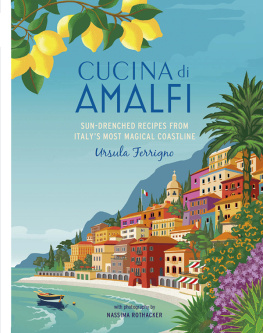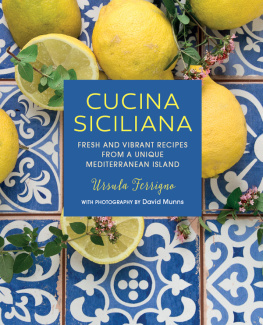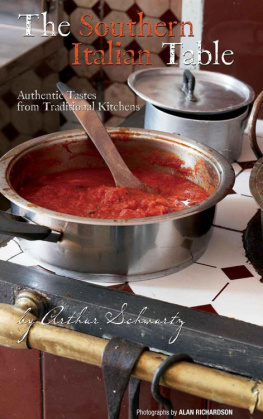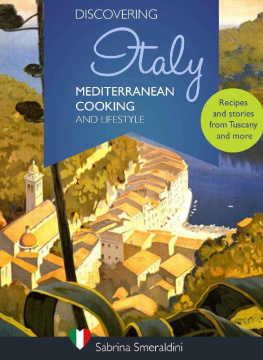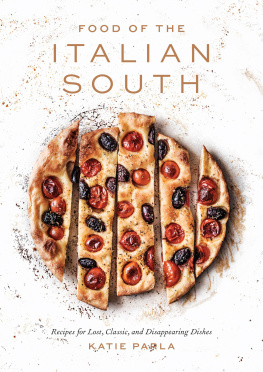CUCINA di
Amalfi


CUCINA di
Amalfi
SUN-DRENCHED RECIPES FROM ITALYS MOST MAGICAL COASTLINE
Ursula Ferrigno
with photography by
NASSIMA ROTHACKER
Illustrations by Colin Elgie


Dedication
To Nicola, my sister, for being so invested in this project for me and for helping with writing recipes, with historiography and for supporting me through this fabulous journey.

Senior Designer Toni Kay
Senior Editor Abi Waters
Head of Production Patricia Harrington
Creative Director Leslie Harrington
Editorial Director Julia Charles
Illustrator Colin Elgie
Food Stylists Eleanor Mulligan and Troy Willis
Prop Stylist Lauren Miller
Indexer Vanessa Bird
First published in 2023 by
Ryland Peters & Small
2021 Jockeys Fields, London
WC1R 4BW
and
341 E 11th St
New York, NY 10029
10 9 8 7 6 5 4 3 2 1
Text Ursula Ferrigno 2023
Design and commissioned photography Ryland Peters & Small 2023 (see for full details)
Printed in China.
The authors moral rights have been asserted. All rights reserved. No part of this publication may be reproduced, stored in a retrieval system or transmitted in any form or by any means, electronic, mechanical, photocopying or otherwise, without the prior permission of the publisher.
ISBN: 978-1-78879-508-1
E-ISBN: 978-1-78879-533-3
A CIP record for this book is available from the British Library.
US Library of Congress cataloging-in-Publication Data has been applied for.
NOTES
All spoon measurements are level unless otherwise specified.
All eggs are medium (UK) or large (US), unless specified as large, in which case US extra-large should be used. Uncooked or partially cooked eggs should not be served to the very old, frail, young children, pregnant women or those with compromised immune systems.
When a recipe calls for cling film/plastic wrap, you can substitute for beeswax wraps, silicone stretch lids or compostable baking paper for greater sustainability.
When a recipe calls for the grated zest of citrus fruit, buy unwaxed fruit and wash well before using.
Ovens should be preheated to the specified temperatures. If using a fan-assisted oven, adjust temperatures according to the manufacturers instructions.
To sterilize preserving jars, wash them in hot, soapy water and rinse in boiling water. Place in a large saucepan and cover with hot water. With the saucepan lid on, bring the water to the boil and continue boiling for 15 minutes. Turn off the heat and leave the jars in the hot water until just before they are to be filled. Invert the jars onto a clean dish towel to dry. Sterilize the lids for 5 minutes, by boiling or according to the manufacturers instructions. Jars should be filled and sealed while they are still hot.
CONTENTS

INTRODUCTION
La Costiera Amalfitana, the Amalfi Coast, is also known as la divina costiera, the divine coast. And to me this is no surprise, because the whole area is magical, with its vertiginous terraces, historic churches and villas, pastel-painted villages clinging to the cliffs, all suspended between a clear blue sky and the sapphire waters of the Mediterranean. The Amalfi Coast is also where I was born and where I lived until I was 12 years old. Our home is the village of Minori, one of the 13 villages officially included in the costiera. Even after we moved to the UK, we would return to Italy every summer to be with my grandparents. To me it was, and still is, a paradise if a little busier now than it was during my childhood!
CAMPANIA & THE AMALFI COAST
The Amalfi Coast is in Campania, one of the southernmost regions of Italy. It is known as Campania Felix happy countryside and I think most of us are indeed happy, living in such a beautiful place, not far from Naples, the lively capital. The villages that dot the Amalfi Coast are, from the west: Positano, Praiano, Furore, Conca dei Marini, Amalfi, Atrani, Ravello, Minori, Maiori, Cetara and Vietri sul Mare; Tramonti and Scala are inland, in the mountains. Often the nearby Salerno, Sorrento, Capri and Naples are associated with the Amalfi Coast, and certainly in a culinary sense they are important.
The major link between most of these small municipalities is a narrow, rollercoaster of a highway, the 43 km (27 mile) Strada Statale 163 (SS163), which twists and turns its way along the clifftops, often single lane and with many sharp turns. The SS163 is perhaps the least amenable of the Amalfi Coast attractions. In high season the road is clogged with tourists driving from one village to another, slowing down to admire the wonderful views, resulting in horrendous traffic jams. (In 2022 the authorities instituted a traffic-calming idea that everyone hopes will help.)
The entire Amalfi Coast has been listed as an UNESCO World Heritage Site because of its unique landscape and natural beauty. Italy holds the greatest number of these heritage sites 58 in total (to rival Chinas 56) and Campania has 10 of them. The award is also based on the areas important cultural heritage. For instance, Amalfi was one of the four major maritime republics of the peninsula (along with Venice, Genoa and Pisa). The town was a major seafaring and trading hub, travelling as far afield as Constantinople (now Istanbul), and instituted the Tavole Amalfitane (the Amalfan tables) in the 12th century, which were then a milestone in maritime law. There are many Greek and Roman sites of interest particularly the Villa Romana in Minori. And of course the Amalfi Coast is not far from the stupendous Roman sites of Pompeii and Herculaneum to the west (both destroyed by Vesuvius in 79AD) and the Greek Paestum to the east, south of Salerno.
In Homers Odyssey, the sirens sing to lure passing sailors to their doom. According to local legend, their island lies just off the Amalfi Coast. Most authorities place the sirens in the Strait of Messina, between Italy and Sicily, but a hotel in Positano is named after the sirens, so the legend must be true!
The Amalfi Coast seems to have acted as a siren song for many people, not just sailors, over the centuries. It was a popular place to visit on the Grand Tours of the 18th and 19th centuries. In the 1850s, Cosima Wagner, wife of the great German composer, described the long journey by mule to the town of Ravello, perched high above the sea. They visited the gardens of Villa Rufolo, and Richard Wagner, after 20 years of composers block, was inspired to finish his opera Parsifal. Years later the town instituted a music festival in his honour, which still exists, running from June to mid-September every year.

